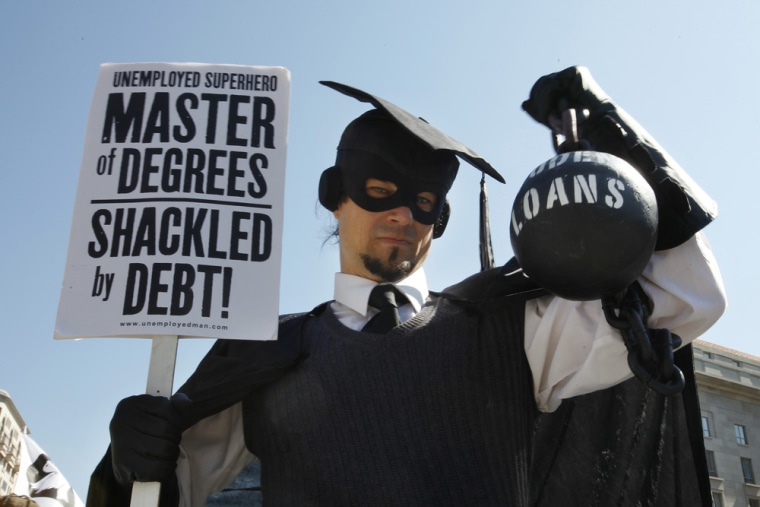Student loan debt is painful for anyone to carry. But if you think the greatest debt burden is falling on the poorest students, think again.
At a time when the cost to attend some colleges exceeds $60,000, lower middle income students carry more student loan debt, on average, than students in any other economic group, according to a forthcoming study.
About 41 percent of the 4,400 students in the study left school with some level of debt. (Seven out of 10 college seniors who graduated in 2012 had student loan debt, averaging $29,400 per borrower, according to a separate study by the Institute for College Access & Success, up from $26,600 in 2011.) But debt burdens did not decrease steadily as students' family income rose.
The study's author, Jason Houle, an assistant professor of sociology at Dartmouth, found that students from families earning $40,000 to $59,000 are incurring about $11,000 more in student loan debt than students from families earning less than $40,000. The lower-middle-income students also incurred more debt than students from families earning between $60,000 and $99,000.
Affluent students' debt burdens were significantly lower than those of any of the middle-class kids.
"Subjects whose families earned $40,000 to $59,000 annually racked up approximately $9,200 more student loan debt than their peers whose families earned between $100,000 and $149,000 per year, and approximately $13,000 more debt than young adults whose families made more than $150,000 annually," Houle said. Students from families with incomes of $60,000 to $99,000 also carried more debt than those from higher-income families.
"It didn't surprise me that kids from affluent backgrounds and whites tended to have less" debt, he said. But "I would have thought I'd see a straight-up negative association between debt and income," where debt decreases as income increases, "and that wasn't the case."
Houle said it is possible that lower middle income students "are just on the wrong side of the financial aid cutoff." Many federal and private financial aid initiatives use family income of $40,000 as a cutoff for grants.
He found that other factors affected student debt burdens, too. Parents' level of education was one factor. Students whose parents did not attend college were at greater risk of taking on debt, as were African-American students and students in single-parent families or families with step-parents.
Then there were the types of colleges students attended. "This middle-income squeeze, or the difference between middle income kids and everyone else, was highest at private, high cost institutions," Houle said.
Many of the most selective private colleges, those with the largest endowments, have been trying to woo high achieving low-income students with lavish aid packages, many of them free of loans.
But those colleges represent only a tiny portion of all private colleges, and many others lack the resources to extend that level of financial assistance.
As for what would make the system more fair, Houle is discreet.
"When we look at these findings, and the fact that parents' backgrounds tend to be strongest at high cost universities, that suggests to me that reducing costs would make sense," he said.
Put more simply, Houle's observation is simple: Colleges need to bring down the cost of attendance. It's perpetuating the existence of a playing field that is far from level.
—By CNBC's Kelley Holland. Follow her on Twitter @KKelleyHolland.
Student loan debt hits another new record
Top colleges to low income students: We want you
College costs are soaring – but not all aid is
